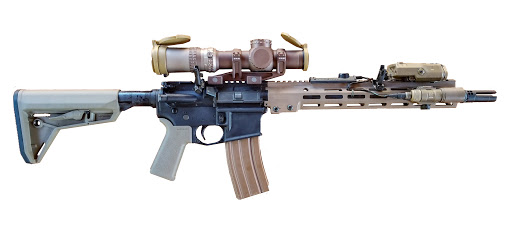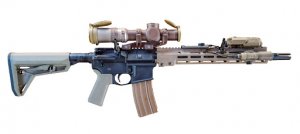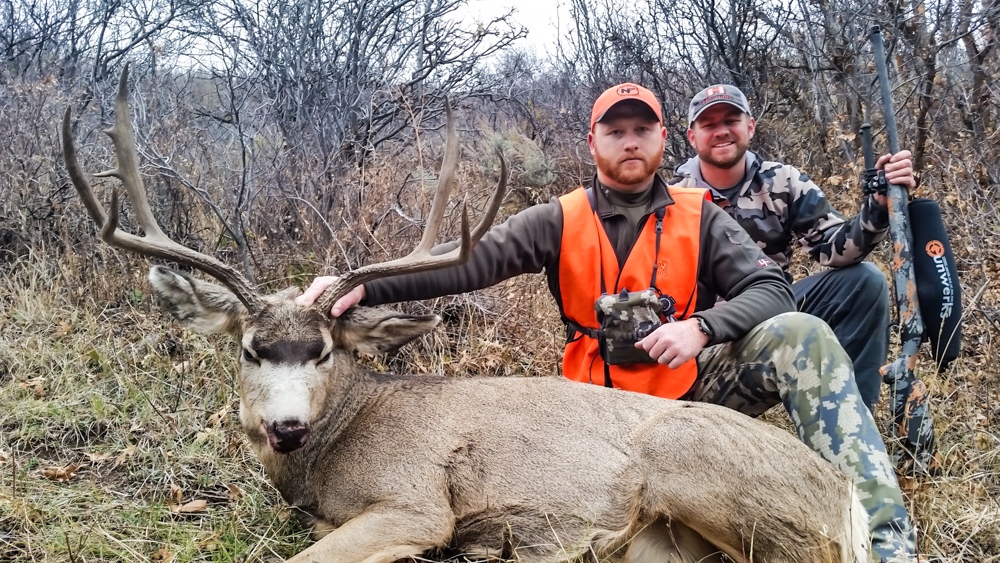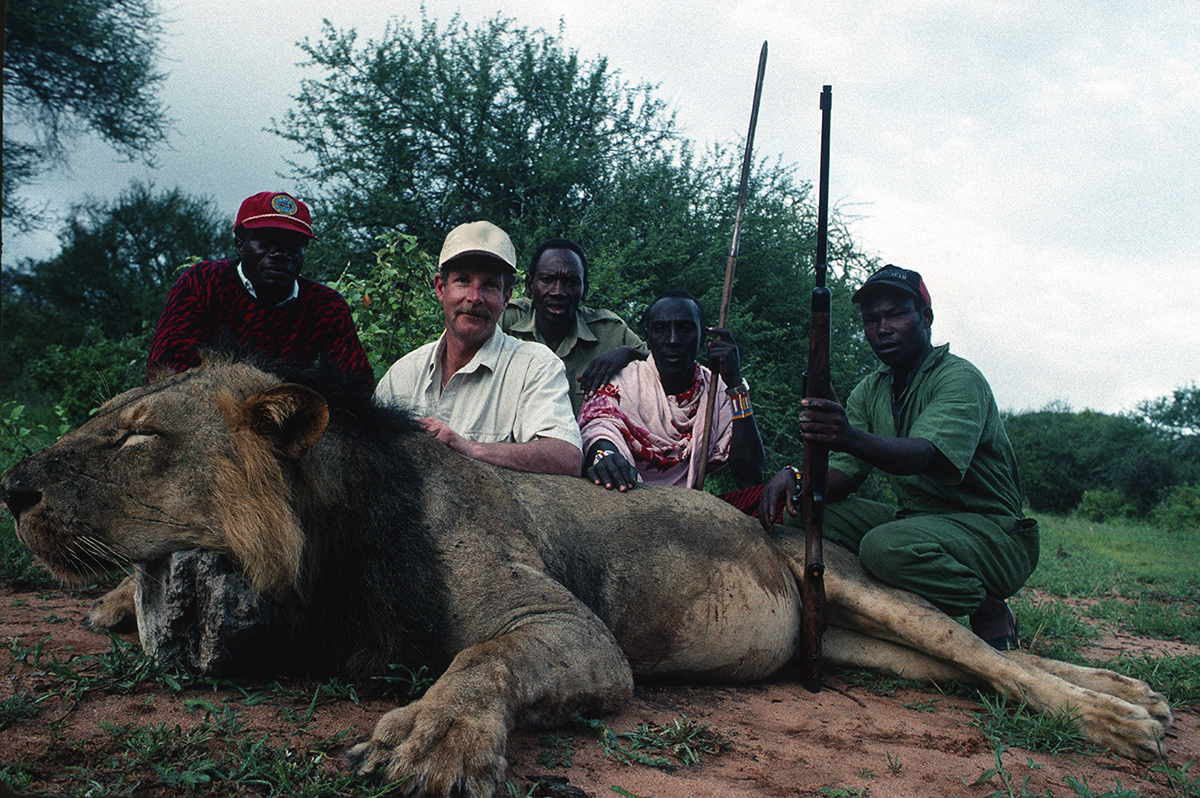It was a very large and very hungry lion, not forty meters from where we sat and sweated. I could hear meat tearing and bones breaking, and an occasional low growl as it dismantled a hapless native cow. I could see nothing, not even the outline of the acacia tree from which the bait hung. The sun had set over an hour ago, and it would be several more hours before the moon rose. Sitting in the African darkness as a lion gorges itself a few paces away makes one wonder about the sanity of big game hunting.
“Get ready,” Leon, my P.H., whispered. I aimed the .375 toward the sound of the carnage and eased off the safety. Our only source of light was a questionable flashlight, powered by three tired third-world batteries.
Leon switched on the weak light, and I found a tawny shape with the scope’s crosshairs. Which end was which? Where do I shoot? Then the beast sensed the light, and turned its great head toward us, ringed by a dark mane. For a moment, it seemed that our eyes met. I found the animal’s shoulder and the rifle’s report shattered the silence of the night.
It sounded like the devil itself, snarling, spitting, roaring, crashing through the bush. Then, just as suddenly, all was still. We waited. Nothing. “I think it’s dead,” Leon said. “I’m pretty certain I hit it well,” I offered, half in truth and half in hope, since searching for a wounded lion in the dead of night is not conducive to a long and happy life. After a rather tense half hour, we ventured from the blind—ever so cautiously—to have a look.
And there it was, dead, not fifty meters from the bait. One shot, through the lungs. It would measure nearly three meters from nose to tail, one of the largest lions taken in the area in many years. The celebration went on well into the night and my long quest for an African lion was over.
For weeks afterward, I relived the event, playing it back in my mind like a digital movie. Exciting? No doubt. Dangerous? Without question. Fortunately, everything had gone well. I couldn’t credit my great shooting, for even I have difficulty missing at forty meters. The rifle? It did its job, to be sure. Hunting prowess? Leon was very skilled and experienced, and he had placed us in excellent position to ambush the great east.
Then it became as clear as the image of that lion—it was the riflescope. Without superb optics, I would never have had a shot. Shooting a lion by the light of a flashlight is not standard procedure. Without a scope that allowed me use every bit of that pathetically minimal light, it would have been impossible.
This was a revelation. Like many hunters, I had never given a scope that much thought. I am a sucker for handsome firearms, and making small sacrifices (such as eating) or composing justifications to my better half that would put a trial lawyer to shame have always been well worth the effort to acquire an elegant new long gun. A scope was an afterthought; a necessary evil that required yet more hard-earned funds.
My encounter with the lion made me see the light, in more ways than one. I had been doing things backwards all those years. In reality, I should have devoted much more attention (and money) to my optics than I did to the gun itself. After all, any decent rifle would have dispatched the lion. On the other hand, if the scope hadn’t allowed a shot, the finest rifle on the planet would have been worthless.
This gave me a newfound interest in hunting optics. I began researching how riflescopes work, what separates a truly outstanding scope from one that is merely adequate, and delving into some of the advertising claims made by various scope companies. What I discovered was, well, enlightening. Rare is the hunter who cannot tell you about the ballistics, bullet performance, action and other pertinent features of his favorite rifle. Ask him about the performance of his scope, though, and chances are you will be met with a blank stare. Or at best, something nebulous about “light gathering” or “coatings” that he read in an article by an “expert” or saw in an advertisement.
That leads us to Truth Number One about riflescopes; there is no riflescope made that can “gather” light. Scopes can only transmit available light. Some do a better job of it than others. The ability of a scope to transmit to your eye the maximum possible available light is what determines whether it will be a sterling performer in near darkness or whether it is best left to noontime use on a sunny day.
Truth Number Two is that it is physically impossible for a riflescope to transmit 100% of available light. As light enters the objective end of the scope, before it reaches your eye it passes through several lenses. Each lens absorbs a small quantity of light. Residual reflection from the individual lenses will also prevent a certain amount of light from passing through the scope. In addition, undesired reflections within the metal tube can hinder the quality of the viewed image and the transmission of light.
Good scope manufacturers devote every waking minute—and great sums of research money—to negating these basic physical limitations of glass and metal. How they do it is fascinating.
It was about this time that my work was involving me in the optics industry, where I had the privilege of working with and learning from makers of some of the finest riflescopes in the world, including NIghtforce.
For example, I thought I knew what light was. It’s what comes through my window in the morning and wakes me up. Or it’s what is insufficient, in the case of hunting lions by flashlight.
Actually, light is simply radiation. This radiation, or rays, consists of waves of varying lengths. The length is the distance between the beginning of the first wave and the beginning of the second wave. . .not unlike a wave on the ocean.
The human eye can perceive light rays between roughly 400 and 800 nanometers in length (one nanometer [nm] = one-millionth of a millimeter). The brain interprets the different wavelengths as colors. For example, blue-violet is in the 400 nm range, extending through blue, green, yellow, orange and finally red at 800 nm.
Oddly enough, the sum total of all the visible wavelengths, seen as daylight, is white. When light strikes a colored object, the object itself filters out certain wavelengths, and we perceive that object in color by the wavelengths that remain. This has profound implications for the hunter and the scope maker both. The human retina has three different types of light-perceiving cells; one for blue-violet, one for green and one for purple. Our blue-violet cells are the most sensitive. Thus, at twilight, blue objects are seen as brighter than red objects. Therefore, it is critical that the coatings used on a scope’s lenses increase the transmission of all available blue light to give us the best chance of seeing what we’re looking at. A good scope will transmit blue light as a neutral image, giving our blue-violet cells every possible opportunity to discern what we are seeing.
To complicate matters, completely different types of cells in our eyes—called “rods”— are responsible for black and white vision (“cones” handle the color). Rods are far more sensitive than cones. So, when we’re trying to discern an animal at dusk, or even after dark, we may not see it in color, but we can see it reasonably well in black and white. That’s why the transmission of blue light as a neutral image is so important.
This is why the coatings used on riflescope lenses (and the skill of the company applying them) is one of the most critical factors in determining the light transmission properties and low light performance of a scope. Virtually every scope manufacturer touts “multi-coated lenses.” That it itself means little, and is often advertising puffery. The quality of manufacturer’s coatings varies widely, from cheap and ineffective to extraordinarily expensive, complex, and remarkably efficient.
Good modern coatings are known as “broadband” coatings because they transmit a broad range of the visible light spectrum (i.e., 350 to 780 nm) with a high degree of efficiency.
The weighting and mixture of different nanometer values of visible light are calculated as “day value” and “twilight value” through a somewhat complicated formula achieved by measuring these values with a spectrophotometer. In simple terms, it compares light of a certain nanometer value as it enters the objective lens of the scope at 100%, then measures the same light at the eyepiece after it has passed completely through the scope. The comparison between the two reveals the percentage of different light values that the scope can transmit.
Lens coatings are carefully guarded secrets, formulated by skilled physicists. Top scope companies calculate the makeup of their coatings in direct relation to the physical composition of the glass to which it is applied, since different batches of glass will react in differing ways to the same coating. Coatings can actually be tailored to favor certain nanometer (color) values, giving preference to certain wavelengths that are most beneficial to the hunter under actual field conditions.
Quality coatings also help minimize reflection from the lenses themselves, enhancing their light transmission ability. Modern coatings that have been tailored to the glass used in a scope’s lenses, then carefully evaporated in high vacuum, will ensure a residual reflection of less than 0.25% per glass/air surface. Each lens has two surfaces. Thus, the total number of lenses within a scope (a variable-power scope can have between seven and ten) is multiplied by two, then multiplied by 0.25% to determine the amount of light lost in the transmission. Simple multiplication is not accurate, however, as each succeeding lens progressively reduces the total amount of transmitted light. It is a favorite technique of some scope manufacturers to claim light transmission values of nearly 100%. Of course, they’re measuring the first objective lens only, conveniently forgetting about the other eight or nine!
How these coatings are applied is just as important. The best scope manufacturers utilize a sophisticated evaporation process in a clean room environment, applying multiple layers of very thin film one layer at a time. It’s not as simple as dunking the lenses in a vat and being done with it.
Truth Number Three about scopes is that the very best riflescopes human beings can create will transmit to your eye—under perfect conditions—slightly over 90% of available light. There are but a handful of scope makers that produce optics approaching these levels.
100% light transmission is physically impossible to achieve with current technology, and claims to the contrary are to be discounted. But, what does light transmission mean in practical terms? A decent scope may transmit 80% or so, inferior scopes substantially less. The human eye can distinguish transmission differences of 3% or more. Consequently, there is a very real difference in what you can see through a superior scope versus run-of-the-mill optics.
Under hunting conditions, when you might be trying to distinguish a target at absolute last light, these differences can be critical. It can determine whether you bag your game or whether you have long since called it a day.
There are, of course, many other factors that determine the quality and capability of a riflescope; certainly the glass itself and its resolving capability, the precision with which lens elements are aligned, the quality and durability of the internal mechanisms, its resistance to recoil, even the reflective qualities of the finish inside the scope’s main tube, to name a few.
But, “light transmission,” “low-light performance,” “light gathering,” and other such terms have been bandied about for so long, they have become virtually meaningless to the consumer. There is not a riflescope manufacturer on earth that doesn’t reference one of these phrases in its advertising claims. Backing up those claims, though, is another matter altogether.
The raw materials, machinery, technology and human resources required to craft a top-quality riflescope do not come cheaply. Building a mediocre scope is actually quite simple. Building precision optics is something altogether different. This is the reason for Truth Number Four about hunting scopes; you get what you pay for. Top-of-the-line scopes are expensive to buy simply because they are expensive to make. The number of riflescope manufacturers building optics of absolute top quality and performance today can be counted on the fingers of one hand. And to tell the truth, you wouldn’t even need all your fingers.
So, does all of this justify laying down a hefty sum for a premium scope? It depends.
If all of your hunting is done in bright daylight, you can get by with an average scope. The truth is, in midday sunlight, you would be hard-pressed to tell the difference between the best riflescope money can buy and one you find on a bargain shelf.
If, though, you’ve ever found yourself struggling to count the points on a huge buck at last light, trying to make out what is lurking in the shadows before sunrise, fighting glare from the setting sun, or lucky enough—maybe foolish enough—to take on several hundred pounds of African lion after dark on the other side of the world, your riflescope will determine whether you go home with the trophy of a lifetime or go home empty-handed.
It might even determine whether you go home at all.
by Tom Bulloch
Tom is a 20+ year consultant to the riflescope industry and has the rare privelege of combining business with pleasure. That’s actually not a correct statement. In his own words he “works to fuel his passion for hunting.”



 Orofino, ID, U.S. – (December 19, 2019) Late last year, the Nightforce Optics MIL-SPEC ATACR™ 1-8×24 F1 was chosen as the First Focal Plane selection for the Squad-Variable Power Scope component of the family of USSOCOM Miniature Aiming System-Day (MAS-D) Optics. The Squad Variable Power Scope is designed to be integrated into current and future anticipated weapons that the US Special Operations Command employ.
Orofino, ID, U.S. – (December 19, 2019) Late last year, the Nightforce Optics MIL-SPEC ATACR™ 1-8×24 F1 was chosen as the First Focal Plane selection for the Squad-Variable Power Scope component of the family of USSOCOM Miniature Aiming System-Day (MAS-D) Optics. The Squad Variable Power Scope is designed to be integrated into current and future anticipated weapons that the US Special Operations Command employ.




 In the modern age of long range shooting, long range marksmen have more information and technology available to them than ever before. Advancements in all areas of the shooting industry have brought obtaining exceptional performance at long range into reach of nearly anyone interested, thus allowing even the most experienced marksmen to extend their ranges. With all of this information being generated, getting it into the hands of shooters to expand their capabilities has become the goal. Bryan Litz started Applied Ballistics LLC when he recognized that there was a lack of information available to shooters, and that much of the information that was available was flawed or inaccurate. This led to the testing of ballistic coefficients and other ballistic characteristics that Applied Ballistics is now known for by using precise, accurate equipment while following the scientific method to obtain precise and useable data.
In the modern age of long range shooting, long range marksmen have more information and technology available to them than ever before. Advancements in all areas of the shooting industry have brought obtaining exceptional performance at long range into reach of nearly anyone interested, thus allowing even the most experienced marksmen to extend their ranges. With all of this information being generated, getting it into the hands of shooters to expand their capabilities has become the goal. Bryan Litz started Applied Ballistics LLC when he recognized that there was a lack of information available to shooters, and that much of the information that was available was flawed or inaccurate. This led to the testing of ballistic coefficients and other ballistic characteristics that Applied Ballistics is now known for by using precise, accurate equipment while following the scientific method to obtain precise and useable data.